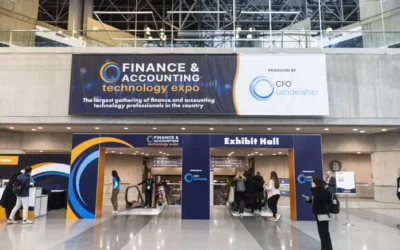When Bobby Leibrock left Red Hat to become CFO of ACI Worldwide in July, he traded one tech institution for another, moving from the largest open-source software company in the world to a mainstay in global payments.
After two decades at IBM, which included leading the acquisition of Red Hat in 2019 and becoming its CFO and COO, he arrived at ACI with a rare combination of operational experience and steady leadership through transformation.
In his first 100 days, he has already led an earnings call, met with dozens of investors and joined ACI’s CEO in driving what he calls a “cultural reboot” toward growth. His mission, he says, is to help the business move faster without losing discipline.
Leibrock spoke with CFO.com about what drew him to ACI, what he learned from two decades at IBM, how he motivates teams after big milestones and why he believes finance leaders need to stay adaptable, analytical and deeply curious.

Bobby Leibrock
CFO, ACI Worldwide
First CFO Position: 2011
Notable previous employers:
- Red Hat
- IBM
This interview has been edited for brevity and clarity.
ADAM ZAKI: What attracted you to ACI Worldwide?
BOBBY LEIBROCK: I wanted to find something in the software space that had the scope of a public CFO role, real growth potential and a culture I could believe in. At Red Hat, I loved the management team I was part of, and I learned that the people you work with matter as much as the product or strategy. So I was selective about who I’d work with next, from the C-suite to the board.
Payments was a newer industry for me, but there were connections that made the opportunity feel familiar. The chairman had been with IBM, the former Red Hat CFO now chairs the audit committee and another board member also came from Red Hat. That built trust before I even took the first meeting.
After talking with the CEO and getting a feel for the business, I saw the potential immediately. ACI has been serving banks and customers globally for almost 50 years, but I felt it was undervalued and underappreciated. What they’ve done at scale is impressive, yet not as widely recognized by investors or even customers. That underdog feeling appealed to me. The company was also in the early stages of a cultural reboot toward growth and modernization. It reminded me of where Red Hat was 10 or 15 years ago, and that felt like the perfect time to join.
You’re just over three months into the role, with today being your 100th day. What has that transition been like?
I’ve been thinking about this because the 100th day is a natural point to reflect. Onboarding into a public CFO role isn’t gradual. My first major assignment was leading the Q2 earnings call just 30 days in. I had been doing homework before starting, but once in the seat, it was all about diving into the data, writing the script, preparing for Q&A and understanding every nuance of our business. It was trial by fire, but it forced me to get up to speed fast.
I viewed that first earnings call as a way to set the tone. It was an opportunity for investors, analysts and employees to see how I communicate, how I think about numbers and how I connect those numbers to strategy. That early transparency helped establish credibility right away.
“You only get one first impression as CFO, and the best way to make it count is to show people you’re listening and learning before trying to lead change.”

-Bobby Leibrock
CFO, ACI Worldwide
After that, my focus split between external and internal priorities. Externally, I met as many investors and analysts as I could. I probably spoke with around 20 in that first month, about half existing holders and half new prospects. I asked a lot of open questions: What do you think ACI does well? What’s misunderstood? Where are the blind spots? That feedback helped shape how I prioritize communication going forward.
Internally, I spent time learning the business from the ground up. I met with engineering, sales, contracting and finance operations to understand how our teams work together. Since I joined, we’ve been in the middle of a three-year strategic plan and our 2026 budget cycle, so there’s been no downtime. It’s been fast-paced, but the team has been exceptional. You only get one first impression as CFO, and the best way to make it count is to show people you’re listening and learning before trying to lead change.
You spent 20 years at IBM, which is rare today when most finance leaders move every few years. What did that kind of tenure teach you about leadership and growth?
The biggest thing was trust. When you spend years with the same people and go through challenges together, they understand how you operate and how you handle pressure. That builds the kind of trust that opens doors to bigger opportunities. At IBM, I was constantly pulled into new roles — FP&A, pricing, M&A, controllership — and that kept me developing in new ways.
It also showed me the importance of depth and integration. When you stay long enough in an organization, you become woven into how it runs. You’re not just delivering financials, you’re influencing decisions across engineering, sales and product. That’s how finance becomes a strategic partner instead of a checkpoint.
The other advantage of longevity is perspective. You start to see cycles — how markets turn, how leadership changes, how transformation efforts succeed or stall. That pattern recognition helps you stay calm in volatile times and make better calls about when to push and when to pause. At ACI, I’ve already seen how valuable that can be. There are people here who have been with the company 10, 15 or even 25 years. Their institutional knowledge and relationships give the organization stability and balance.
CFOs often say the real work begins after big milestones like acquisitions or IPOs. During your career, but particularly after the Red Hat acquisition, how did you keep your people motivated?
I’ve lived that many times. At IBM, I was involved in both the deal-pursuit and post-merger integration sides. When Red Hat was acquired, I helped build the business case before the deal and then ran the integration afterward. It was motivating because it was like, “you convinced us this was a good bet, now go make it work.”
The most important thing is alignment on the why. Every deal or milestone has value drivers, and those become your north star. If it’s an IPO, maybe it’s access to capital for growth. If it’s an acquisition, maybe it’s about unifying technology or expanding reach. When everyone understands the why, they stay focused through the messy middle.
You also have to keep people connected to the outcome. Celebrate the milestone, but quickly pivot to what it enables next. Momentum can fade fast if you don’t channel it. At Red Hat and now at ACI, I’ve seen how much more sustainable motivation becomes when people understand how their hard work links directly to the company’s next goal.
You also served as COO at Red Hat, which gave you oversight of functions beyond finance. That dual role is becoming more common. What did you take from that experience that you’ve brought into this role?
That experience shaped how I think about leadership. A mentor once told me that as CFO, you’re not just responsible for the financial health of the company, you’re responsible for the overall health of the company. That means understanding how every decision impacts people, culture and customers.
At Red Hat, my scope included legal, IT, finance, accounting and HR. It taught me how to lead across functions that speak different languages. Every leader shows up with their own perspective, and it’s easy for functions to optimize locally without seeing how their decisions affect others. The key is to connect those dots.
In a software company, roughly 80% of your workforce are engineers and salespeople, so I use what I call the “unit of one” test. Before rolling out any new process or policy, I ask how it will affect one developer or one seller trying to hit their goals. If you can’t explain the benefit clearly at that level, you probably need to rethink the change.
That perspective helps me at ACI, too. We’re going through our own cultural and operational evolution, and making sure every change feels connected rather than disruptive is a big part of my job.
What does technology inside your finance function look like right now, and how, if at all, do you plan to evolve it?
ACI has a solid technology foundation, which is great to build from. My focus is on pushing that foundation toward predictive and analytical capabilities, especially through AI. I’ve spent my entire career in and around software, and I think we’re still only scratching the surface of what’s possible in finance.
I’m a big believer in using AI, not just for efficiency but for insight. It’s not about replacing the human element; it’s about helping people make faster, smarter decisions. I try to lead by example. I’ll build small applications myself —sometimes using Claude or other models — to automate tasks like tracking ownership changes, analyzing revenue trends or flagging anomalies in data. When people see that curiosity coming from the top, it encourages experimentation across the team.
In previous roles, I worked on automating tax compliance, reconciliations and statutory reporting with AI-assisted tools. Those projects showed me that the real value isn’t in the automation alone but in freeing people to think more strategically. At ACI, I want to replicate that — use technology to create space for better thinking, not just faster reporting.
We also partner closely with technology providers and consulting firms that bring domain knowledge and large data repositories we can learn from. I’m very conscious of staying flexible. This technology evolves every quarter, and you have to keep testing, learning and moving forward without locking yourself into one system or mindset.
On your LinkedIn profile, your job description includes the phrase “operational excellence.” How do you quantify and/or qualify that in reality?
I look at operational excellence through two lenses: quantitative and qualitative. Quantitatively, it’s about doing the fundamentals right. That means reliable reporting, strong controls, accurate forecasting, efficient payroll and collections—everything that builds credibility.
Qualitatively, it’s about influence. You can have great analytics and dashboards, but if no one acts on the insights, it doesn’t matter. I use the analogy of a personal trainer. Anyone can work out alone, but a trainer helps you show up and stay accountable. Finance is the personal trainer for the business. We help leaders make decisions they might not make on their own, or see tradeoffs they might overlook.
That influence is what separates a good finance team from a great one. When you earn that trust, you become part of the decision-making process early instead of reacting after the fact. That’s what I mean by operational excellence—finance operating at the speed of the business, not behind it.





